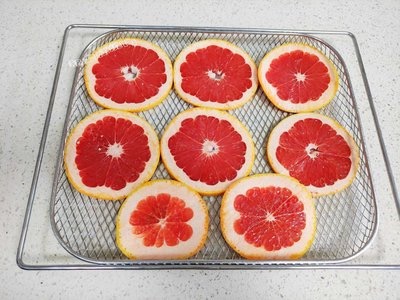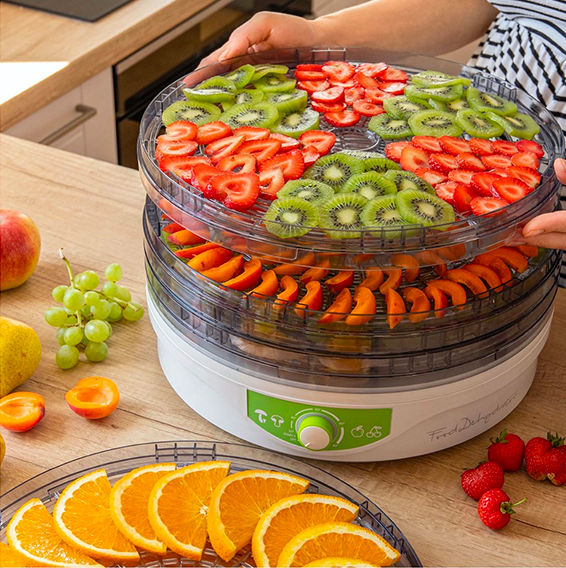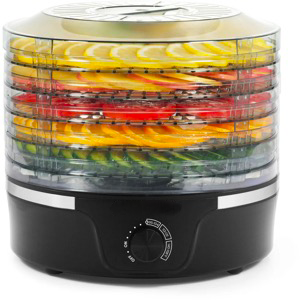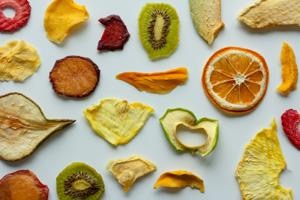
Content Menu
● Understanding Food Dehydrators
>> How Food Dehydrators Work
● Benefits of Using Food Dehydrators
● Types of Food Dehydrators
● Heat Pump Technology in Food Dehydration
>> Advantages of Heat Pump Technology
● Installation Considerations
>> Key Installation Steps:
● Common Uses for Food Dehydrators
>> Creative Uses for Dried Foods
● Tips for Successful Dehydration
>> Pre-treatment Techniques
● Storage of Dehydrated Foods
>> Long-Term Storage Solutions
● Troubleshooting Common Issues
● Conclusion
● Frequently Asked Questions
>> 1. What types of foods can be dehydrated?
>> 2. How long does it take to dehydrate food?
>> 3. Can I dehydrate frozen or cooked foods?
>> 4. What is the ideal temperature for dehydration?
>> 5. How should I store my dehydrated foods?
Food dehydrators are essential appliances in both home and commercial kitchens, allowing users to preserve various foods by removing moisture. This article will explore the intricacies of food dehydrators, focusing on their functionality, benefits, types, and the role of heat pump technology in dehydration processes.

Understanding Food Dehydrators
A food dehydrator is a device designed to remove moisture from food items, thereby extending their shelf life and preserving their nutritional value. By circulating warm air at low temperatures, typically between 95°F to 165°F (35°C to 74°C), dehydrators prevent the growth of bacteria, yeast, and mold.
How Food Dehydrators Work
The dehydration process involves several key components:
- Heating Element: Provides the necessary warmth to evaporate moisture.
- Fan: Circulates air throughout the dehydrator to ensure even drying.
- Trays: Hold the food items in place while allowing air to flow around them.
When food is placed in a dehydrator, the heated air moves across the trays, evaporating moisture from the surface of the food. This process continues until the desired dryness is achieved.
Benefits of Using Food Dehydrators
Utilizing a food dehydrator offers numerous advantages:
- Extended Shelf Life: Dehydrated foods can last for months or even years when stored properly.
- Nutritional Preservation: Dehydration retains most of the vitamins and minerals found in fresh produce.
- Cost Efficiency: By preserving seasonal fruits and vegetables, users can save money and reduce waste.
- Flavor Enhancement: The dehydration process intensifies flavors, making dried foods more delicious.
- Healthy Snacking: Dried fruits and vegetables make for nutritious snacks without added sugars or preservatives.
Types of Food Dehydrators
There are several types of food dehydrators available on the market:
- Convection Dehydrators: These are equipped with fans that circulate hot air around the food. They are effective for even drying and are commonly used in both home and commercial settings.
- Stackable Dehydrators: These models consist of multiple trays stacked on top of each other. They are compact but may require more attention to ensure even drying.
- Heat Pump Dehydrators: Utilizing advanced technology, these units recycle heat and use lower temperatures for drying. They are energy-efficient and provide precise control over temperature and humidity.
Heat Pump Technology in Food Dehydration
Heat pump technology represents a significant advancement in food dehydration. Here's how it works:
- Energy Efficiency: Heat pump dehydrators use less energy compared to traditional models by recycling warm air within the unit. This results in lower operational costs.
- Gentle Drying: By operating at lower temperatures, heat pump dehydrators preserve the color, flavor, and nutritional content of foods better than conventional dehydrators.
- Controlled Environment: These units allow for precise control over temperature and humidity levels, reducing the risk of spoilage or mold growth during the dehydration process.
Advantages of Heat Pump Technology
In addition to energy efficiency and gentle drying, heat pump technology offers other benefits:
- Versatility: Heat pump dehydrators can be used for a wide range of foods including fruits, vegetables, meats, and herbs. This versatility makes them suitable for both home cooks and professional chefs.
- Reduced Noise Levels: Many heat pump models operate more quietly than traditional dehydrators, making them ideal for use in residential settings.
- User-Friendly Features: Many modern heat pump dehydrators come equipped with digital controls that allow users to set specific drying times and temperatures based on their needs.
Installation Considerations
When considering a heat pump food dehydrator for your business or home kitchen, installation requirements are minimal. Unlike some appliances that require plumbing connections (such as washing machines), heat pump dehydrators typically only need an electrical outlet for operation.
Key Installation Steps:
1. Location Selection: Choose a well-ventilated area with easy access to an electrical outlet.
2. Level Surface: Ensure that the unit is placed on a stable surface to prevent vibrations during operation.
3. Power Connection: Plug the unit into an appropriate power source as specified by the manufacturer.
4. Initial Setup: Follow any specific setup instructions provided by the manufacturer regarding tray placement and initial settings.
5. Ventilation Requirements: Ensure there is adequate space around the unit for airflow; this is particularly important for heat pump models that rely on air circulation for efficiency.

Common Uses for Food Dehydrators
Food dehydrators can be used for a variety of applications:
- Fruits and Vegetables: Perfect for making dried fruits like apples, bananas, and tomatoes.
- Meats: Ideal for creating jerky or preserving cooked meats.
- Herbs and Spices: Great for drying herbs like basil, thyme, or rosemary for later use.
- Snacks: Users can create healthy snacks such as fruit leather or vegetable chips without added preservatives.
Creative Uses for Dried Foods
Beyond traditional uses, dried foods can be incorporated into various culinary creations:
- Granola Bars: Dried fruits can enhance homemade granola bars with natural sweetness.
- Soups and Stews: Dried vegetables can be rehydrated in soups or stews, adding flavor without compromising nutrition.
- Baking Ingredients: Dried fruits like raisins or cranberries can be added to baked goods for extra texture and taste.
Tips for Successful Dehydration
To achieve optimal results when using a food dehydrator:
- Prepare Food Properly: Cut food into uniform sizes to ensure even drying.
- Avoid Overcrowding Trays: Leave space between pieces to allow air circulation.
- Rotate Trays Periodically: If using a stackable model, rotate trays during drying to promote uniformity.
Pre-treatment Techniques
Some foods benefit from pre-treatment before dehydration:
- Blanching Vegetables: Briefly boiling vegetables before drying helps preserve color and flavor while also reducing enzyme activity that can lead to spoilage.
- Citrus Juice Soaking: Soaking fruits like apples or bananas in citrus juice prevents browning during dehydration.
Storage of Dehydrated Foods
Proper storage is crucial to maintain the quality of dehydrated foods:
- Store in airtight containers or vacuum-sealed bags.
- Keep in a cool, dark place to prevent moisture absorption and spoilage.
Long-Term Storage Solutions
For those looking to store dried foods long-term:
- Use Mylar bags with oxygen absorbers to extend shelf life significantly.
- Consider refrigeration or freezing dried foods if you live in a humid climate to further prevent moisture absorption.
Troubleshooting Common Issues
Users may encounter some common issues with food dehydrators:
1. Uneven Drying:
- Ensure proper airflow by not overcrowding trays.
- Rotate trays periodically during operation.
2. Sticking Foods:
- Use non-stick sheets or lightly grease trays before placing food on them.
3. Off-Flavors:
- Clean your dehydrator thoroughly before each use to avoid residual odors affecting your foods.
4. Excessive Drying Time:
- Check temperature settings; higher temperatures may reduce drying time but can compromise quality if too high.
- Ensure that your unit is functioning correctly; if it seems inefficient, consult the manufacturer's troubleshooting guide.
5. Moisture Retention After Drying:
- Make sure foods are completely dry before storing; if unsure, allow additional time in the dehydrator.
- Test dryness by checking if pieces snap easily rather than bending; this indicates proper dehydration levels have been reached.
Conclusion
In conclusion, food dehydrators are invaluable tools for preserving food while maintaining its nutritional integrity and flavor. With advancements like heat pump technology enhancing efficiency and effectiveness, these appliances have become essential in both home kitchens and commercial operations. By understanding how they work and following best practices for use and storage, users can enjoy delicious dried foods year-round.

Frequently Asked Questions
1. What types of foods can be dehydrated?
A wide variety including fruits, vegetables, meats, herbs, and snacks like jerky or fruit leather can be effectively dried using a food dehydrator.
2. How long does it take to dehydrate food?
Drying times vary based on food type but can range from several hours to over a day depending on moisture content and thickness of slices used during preparation.
3. Can I dehydrate frozen or cooked foods?
Yes! Frozen foods should be thawed first before placing them in the dehydrator; cooked foods may require less time than raw ones due to pre-existing moisture loss during cooking processes.
4. What is the ideal temperature for dehydration?
Most foods dehydrate well at temperatures between 130°F (54°C) to 160°F (71°C). However, specific items may have unique temperature preferences based on their water content and texture requirements during drying processes.
5. How should I store my dehydrated foods?
Store in airtight containers or vacuum-sealed bags in a cool, dark place for maximum shelf life while ensuring minimal exposure to light or humidity which could lead towards spoilage over time.












